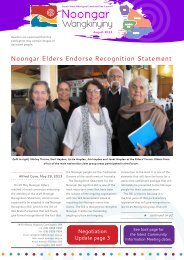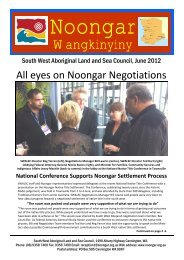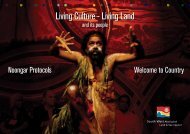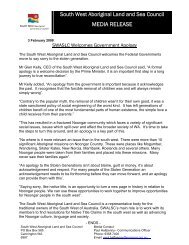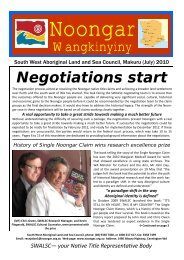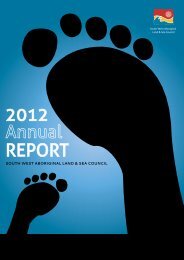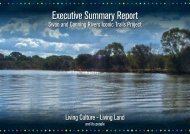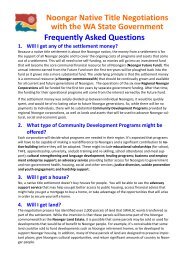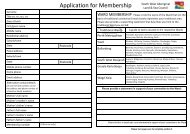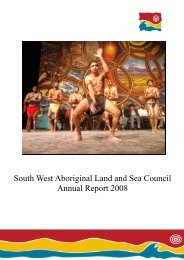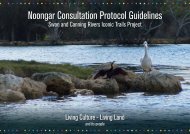Noongar News October 2012 - South West Aboriginal Land & Sea ...
Noongar News October 2012 - South West Aboriginal Land & Sea ...
Noongar News October 2012 - South West Aboriginal Land & Sea ...
You also want an ePaper? Increase the reach of your titles
YUMPU automatically turns print PDFs into web optimized ePapers that Google loves.
<strong>South</strong> <strong>West</strong> <strong>Aboriginal</strong> <strong>Land</strong> and <strong>Sea</strong> Council<strong>October</strong> <strong>2012</strong>Readers are cautioned that thispublication may contain images ofdeceased people.Negotiations Moving Towards Agreementin PrincipleSWALSC, <strong>October</strong> <strong>2012</strong>The negotiations aimed at resolvingthe <strong>Noongar</strong> native title claims areprogressing well, with discussionsbetween SWALSC and the State ofWA possibly being finalised by the endof <strong>2012</strong>. At that point, it will be up tothe <strong>Noongar</strong> community to decide if itwants to accept the agreement. Claimgroup authorisation meetings to vote onthe package are likely to be held in thefirst half of 2013.The fourth round of negotiations washeld in May this year, where discussionstook place on all the major Heads ofAgreement matters. Following thosetalks, and under instruction from the<strong>Noongar</strong> Negotiation Team, SWALSCproduced a series of position paperswhich documented the <strong>Noongar</strong>position. This process has successfullyclarified the areas where we feel weare close to agreement, the areaswhere there is still some way to go,and the issues where there are stillmatters outstanding. This will assistparties in their desire to get closer toan Agreement in Principle following thefifth round of negotiations which aredue to begin in early <strong>October</strong>. After thatThe Government has agreed to pass an act of the WA parliament recognising<strong>Noongar</strong> people as the Traditional Owners of the <strong>South</strong> <strong>West</strong>.we will be able to give <strong>Noongar</strong> people and services for <strong>Noongar</strong>s in a way thata clearer idea about what an Agreement only <strong>Noongar</strong> people can. In other areasin Principle will look like. Progress on all of community development, <strong>Noongar</strong>smatters is outlined below.will enter into partnerships with otherproviders, or may attempt to influenceCommunity Developmentmainstream service delivery throughFrameworkmembership of key over-sight bodies. IfSWALSC outlined a position on the SWALSC was pursuing the native titleCommunity Development Framework claims through the courts, instead ofwhich clearly identified a <strong>Noongar</strong> seeking to resolve the claims throughdomain as an area of self-determination negotiations with the State, therewhere <strong>Noongar</strong> culture is paramount. In would be no community developmentthis space, <strong>Noongar</strong>s will run programs component in the settlement.continued on p21490 Albany Highway Cannington, WAPh: (08) 9358 7400Fax: (08) 9358 7499Email: reception1@noongar.org.auWeb: www.noongar.org.auPostal Address: PO Box 585Cannington, WA 6987Negotiations <strong>News</strong>continued on page 2Mogumberpage 7
2Negotiation <strong>News</strong> continued from p1Recognition of TraditionalOwnershipThe one thing that native title law doeswell (if you win in court) is to providerecognition of Traditional Ownership.SWALSC has secured a commitmentfrom the State that a negotiatedsettlement of <strong>Noongar</strong> claims willresult in an Act of WA Parliament thatalso recognises <strong>Noongar</strong> people as thetraditional owners of the south west. The<strong>Noongar</strong> Recognition (Koorah YehyehBoorda – past, present, future) Actwill include a preamble and a <strong>Noongar</strong>recognition statement. This historicstatement could one day sit alongsidethe Commonwealth Government’sapology to <strong>Aboriginal</strong> Australians inschools across the south west.<strong>Land</strong> BaseThere is still some way to go beforeany final agreement can be achieved ona <strong>Land</strong> Base. The State has indicated itwishes to transfer approximately 200,000 hectares into <strong>Noongar</strong> ownership,with discussions currently centred onsecuring land in and around the townsin the south west. By comparison, asuccessful native title claim in theFederal Court under the Native Title Actwould result in no land being transferredto <strong>Noongar</strong> ownership. This is becausenative title does not in fact give peoplea real title, just the right to carry outtraditional activities on land. Under the<strong>Land</strong> Access section of negotiations,SWALSC is confident it has securedthe right for <strong>Noongar</strong>s to practice thesecustomary activities.Economic BaseSWALSC continues to argue for anincrease in the Economic Base (thefinancial component of the State’soffer). Advice received from externalconsultants suggests that, to besustainable, <strong>Noongar</strong>s will need morethan the $60 million per year for tenyears for the future fund, and morethan $10 million per year for tenyears for <strong>Noongar</strong> Traditional OwnerCorporations that the State is currentlyoffering. Nevertheless, this offer ranksthe <strong>Noongar</strong> settlement very highlyon a world scale (see "Report shows<strong>Noongar</strong> Settlement is 'World Class'",page 5). By contrast, a successful nativetitle court case under the Native TitleAct would provide zero financial benefitto the <strong>Noongar</strong> community, with littleor no funding being provided for thesingle prescribed body corporate thatwould be required to manage native title.These prescribed bodies corporate havea long history of going broke.Governance by TraditionalOwner CorporationsIn the Governance component ofthe offer, the State has agreed tofund six regional Traditional OwnerCorporations, and one central <strong>Noongar</strong>support body. This strongly reflectsSWALSC’s guiding principle to ensuredecisions affecting <strong>Noongar</strong> peopleare made by <strong>Noongar</strong> people in theregions. Discussions continue aboutarrangements for the <strong>Noongar</strong> BoodjaTrust, which will hold funds and landtitles. While they share the State’sdesire for good governance, SWALSCand the <strong>Noongar</strong> Negotiation Teamhave strongly advocated that <strong>Noongar</strong>sneed to be in control of <strong>Noongar</strong> assets.INDEXNegotiations <strong>News</strong> p1-5SWALSC <strong>News</strong> p6-8Community <strong>News</strong> p9-14<strong>Land</strong> AccessGovernance InfrastructureFunds$Community Development
Negotiation <strong>News</strong> 3 continued from p2HeritageDiscussions about a new Heritageregime have also progressed well.Improved management of <strong>Noongar</strong>heritage will take place throughan agreed Heritage Charter, and anew <strong>Noongar</strong> Standard HeritageAgreement. More resources will be putinto protection of <strong>Noongar</strong> heritage,primarily through the Traditional OwnerCorporations.Alternative to Future ActsThe native title process currentlyprovides the <strong>Noongar</strong> people witha right to negotiate over new landdevelopments (or Future Acts), andthis right is currently worth about $2.5million per year to <strong>Noongar</strong>s (and that’sin the time of a mining boom). As analternative to Future Acts, the State isdiscussing the convening of an EconomicReference Group giving <strong>Noongar</strong>representatives the opportunity toincrease their participation in the WAeconomy. The financial component ofthe State’s offer far outweighs anybenefit the <strong>Noongar</strong>s derive through thecurrent native title Future Act regime.Joint Management ofConservation EstateSome time ago the State presenteda proposal on Joint Management ofConservation Estate (State Forestand National Parks) that was broadlyacceptable to SWALSC and the <strong>Noongar</strong>Negotiation team. Ths proposal gavea central role to Traditional Owners inmanaging their country, as well as toemploying a number of <strong>Noongar</strong> peoplewithin the Department of Environmentand Conservation (DEC).Housing and <strong>Noongar</strong>Cultural CentreSWALSC is also using the negotiationprocess to discuss and progressother issues such as Housing, and theestablishment of a <strong>Noongar</strong> CulturalCentre (primarily for <strong>Noongar</strong> culturaldevelopment rather than just fortourism). Firm commitments fromthe State have been received on theseissues. It should be noted that issuessuch as housing, and establishment ofa <strong>Noongar</strong> Cultural Centre would neverbe included in any successful native titlesettlement through the Federal Courtunder the Native Title Act.While there is still a long way to gountil <strong>Noongar</strong>s vote on a final agreement,it is fair to say that good progress hasbeen made in recent months. Boththe <strong>Noongar</strong> Negotiation Team andSWALSC staff have been working hardto secure the best possible outcomefor <strong>Noongar</strong> people – an outcome thatwill strengthen the <strong>Noongar</strong> peopleculturally, socially, and economically.Community or FamilyInformation MeetingsSWALSC will soon be engaging inanother round of community and familyinformation meetings designed toprovide detailed information about theprogress of the negotiations.If you’d like SWALSC to hold ameeting for your family group, or yourlocal <strong>Aboriginal</strong> organisation, pleasecontact SWALSC.If you see an advert for a CommunityInformation Meeting please feel freeto come along and find out the latestinformation about the progress of thenegotiations and have your say on thishistoric nation building opportunity.Economic ParticipationCustomary RightsCulture & HeritageJoint Management<strong>Land</strong>
4Negotiation <strong>News</strong>From left to right: (back row, standing) Gail Beck, Carol Innes, Sarah Bell, (front row, seated) Maryse Aranda, Malcolm Firth,Stuart Bradfield, Glen Kelly (SWALSC, CEO), and Jody BrounMore eyes on NegotiationsSWALSC, September <strong>2012</strong>In early September SWALSC staffmet with Jody Broun, who is Co-Chair of Australia’s peak <strong>Aboriginal</strong>representative body, the NationalCongress of Australia’s First Peoples.SWALSC CEO Glen Kelly provided abriefing to Ms Broun on the progress ofthe negotiations aimed at resolving the<strong>Noongar</strong> native title claims. Ms Brounsaid “<strong>Aboriginal</strong> people across thecounty are watching closely.” Ms Broundescribed the Congress's process asoutlined by their <strong>Aboriginal</strong> membership,which includes: First people’s rights,culture, leadership, unity, empowerment,and sustainability. SWALSC staffreflected that all these principles werein some way addressed by the <strong>Noongar</strong>native title negotiations.The Congress was formed in 2010 toadvocate for recognition of the statusof <strong>Aboriginal</strong> and Torres Strait Islanderpeoples as First Nation peoples. Morerecently, the Congress has been travelingaround the country meeting with<strong>Aboriginal</strong> communities to discuss therecognition of <strong>Aboriginal</strong> people in theAustralian Commonwealth Constitution.Membership to the Congress is free andopen to <strong>Aboriginal</strong> and Torres StraitIslanders over 18. For more informationon the National Congress of Australia’sFirst Peoplesvisit:www.nationalcongress.com.au
Negotiation <strong>News</strong> 5Report shows <strong>Noongar</strong> Settlement isWorld ClassA new report written by the MercerInternational investment consultancyorganisation rates the WA Governmentoffer to <strong>Noongar</strong> people internationallyin the top category of similar agreements.While the offer has yet to be finalised,or accepted by <strong>Noongar</strong> people, theterms that have been offered by theState so far mean that the offer ranksalongside the largest land settlementsincluded in the study.SWALSC sought advice from theMercer International consulting firmon the way other First Nations havemanaged the financial benefits whichhave flowed from similar negotiationswith government. The report looked atsimilar land base settlements concludedin New Zealand, Canada, the UnitedStates and the <strong>South</strong> Pacific. The offerprovided by the WA Government to<strong>Noongar</strong> people placed it as the thirdlargest of the 13 agreements studied byMercer.It was also encouraging to note thattwo of the report’s key findings relatingto good governance have already beenincorporated into the governancestructures proposed for the <strong>Noongar</strong>post-settlement arrangements. Theserelated to the need to build up significantcapital reserves before settlementmonies were spent, and also the needto clearly separate the work relating to<strong>Land</strong> and Culture, on one hand, fromFinances on the other.A number of important lessons werelearnt by examining the way other FirstNations were able to strike a balancebetween generating wealth for futuregenerations, while also providingimportant social benefits for peopletoday. These included recognitionof elders, support for education andcommunity development, as well asboosting First Nation employment andbusiness development.Having consulted with <strong>Noongar</strong>sacross the south west for the pasttwo years, SWALSC is ensuring theseare part of any <strong>Noongar</strong> Native TitleSettlement.Anyone interested in reading thereport should contact SWALSC on9358 7436 and we’ll post one to you.Charlie Perkins ScholarshipThe annual Charlie Perkins Scholarship is now open forapplications for the 2013/2014 study period. The scholarshipwas conceived to put two talented <strong>Aboriginal</strong>s throughpostgraduate courses at the University of Cambridge or theUniversity of Oxford in the UK. The scholarship is intendedto help <strong>Aboriginal</strong>s who have potential to be leaders in theircommunity or field of study.The scholarship covers travel costs to the UK, all universityfees and charges, and living expenses up to £13,800 GBP($21,600 AUD) annually. To be eligible you must:• Be of <strong>Aboriginal</strong> or Torres Strait Islander descent,• Have a tertiary qualification, and• Be accepted into a graduate degree program offered atthe University of Cambridge or the University of Oxford.Applications close 5pm AEST Friday 2 November <strong>2012</strong>.For more information including how to apply visitwww.perkinstrust.com.au
6SWALSC <strong>News</strong>Kaartdijin <strong>Noongar</strong>SWALSC, September <strong>2012</strong>The exciting news for Kaartdijin<strong>Noongar</strong> is the re-vamping of ourwebsite. In late <strong>October</strong> Kaartdijin willhave a vibrant and colourful new look.To reflect the new website and theexpansion of the project, the Kaartdijinbrochure has been redesigned toincorporate all the rich colours anddiversity of <strong>Noongar</strong> country and culture.This year we have developed apartnership with the AustralianIndependent Schools Association(AISWA) to bring <strong>Noongar</strong> content tothe National Curriculum. As of 2014,Australian schools will be required toinclude <strong>Aboriginal</strong> and Torres StraitIslander content across all subjects. Wehave used this opportunity to promoteand celebrate <strong>Noongar</strong> culture andheritage.Kaartdijin has also collaborated withPolytechnic <strong>West</strong> by providing linksand specific <strong>Noongar</strong> content for theirinternal Moorditj Moodle website. TheMoorditj Moodle was launched in Mayand was enthusiastically welcomed byall who attended.In June, Kaartdijin was part of the<strong>Aboriginal</strong> Culture Expo in the city,where teachers from the independentMoorditj Moodle Launch. Front row: (left to right) Denise Cook, Lisa Litjens,Margaret Drayton, Carol Innes (Kaartdijin), Derek Nannup, Angela Ryder. Back row:Wayne Collyer, Sandra Rotaunah, Collene Castle (Polytecnic <strong>West</strong>)schools sector could source a range ofeducational opportunities for teaching<strong>Aboriginal</strong> studies as part of the newNational Curriculum. All the teacherswere excited about Kaartdijin and theSchools, and funding for a new projectmanager, there is a bright future for thewebsite, which aims to share <strong>Noongar</strong>culture and history with all <strong>Noongar</strong>sand with the wider world.possibilities for including <strong>Noongar</strong> If you would like to share a story orculture into their lesson programs.With the new look for Kaartdijin<strong>Noongar</strong>, the continuing collaborationwith the Association of Independentphotograph with Kaartdijin <strong>Noongar</strong>,please contact us:Email: kaartdijin@noongar.org.auPhone: 9358 7400<strong>Noongar</strong> BookmarksBilingual <strong>Noongar</strong> to EnglishLocal <strong>Aboriginal</strong> languageCulturally approvedLocally made in WA!Order some today:amy.williams@noongar.org.auKids will love them!
SWALSC <strong>News</strong> 7Mogumber Mission UpdateSWALSC, September <strong>2012</strong>The Mogumber Mission InterimAdvisory Group (MMIAG) is progressingthe plan on behalf all <strong>Aboriginal</strong> people.A key achievement has been securingthe agreement from the WA Minister forIndigenous Affairs for a short term lease.The lease is seen as an interim step tofacilitate the transfer of the propertyinto <strong>Noongar</strong> ownership, and toprovide the necessary time to establishformal management structures, andclear direction for the cultural, social,commercial and environmental future ofthe property.The Mogumber Mission InterimAdvisory Group (MMIAG) is responsiblefor managing the lease on behalf of theYued People, members of the StolenGenerations, and all <strong>Aboriginal</strong> peopleuntil such time as the formal Board/s ofManagement are established.A priority for the MMIAG is theestablishment of the future governancestructure and the formation of boardsof management to make decisionsand progress the planning and reestablishmentof Mogumber Missionand Farm. Other current initiatives thatare being undertaken by the MMIAGinclude:• The establishment andimplementation of a worksprogram.• Developing a StrategicWater Plan (including a FarmManagement Water Plan).• An assessment of the health ofthe pine trees in the CulturalPrecinct area.• An evaluation of the pineplantations.• A feasibility/assessment offarming/cropping options.• A structural engineering reporton the “Mission Church”.• Establishment of the MMIAGFacebook page, and web site.
8SWALSC <strong>News</strong>Employment Forum atEsperance Yacht ClubSWALSC, August <strong>2012</strong>An employment forum was heldat the Esperance Bay Yacht Club inEsperance on 23 August. The forumoffered an opportunity for local boysfrom the Clontarf Football Club, andbusiness operators such as FQM to talkto the boys about their skills, goals andaspirations for the future.The football team at Clontarf playsagainst other local football teams. Thelocal business operators there offerthem work on a weekend basis. If aperson is shown to be good they areoffered a more permanent position.Clontarf Football club also organisesthe team to do work experience withbusinesses so the transition fromschool into the workforce is easier. Inreturn the businesses help write theirresumes for them.Clontarf has been going in leaps andbounds and they are the only one thatis happening like that in the region. TheForum also provided an opportunity forSWALSC to work out how we couldassist them.GKB Industry ForumBy Michelle Nelson-CoxThe Industry Forum is looking at atraining competency-based modelthat is industry related for potentialcandidates from the GKB region.The Industry Forum is keen toexplore employment opportunitiesfor <strong>Aboriginal</strong> people with establishedmining industries around the GKBregion. Future investments in futureemployees will enable them to retain oneform of training, qualifying them withongoing skills with the other industries.For example employees will be able totransfer their skills from one companyto another such as Newmont to PremierCoal. The training will be baseline entry.The forum is focusing on best practicemodels for recruitment and retention,and having the flexibility in eliminatingnon-serious criminal offences. MichelleNelson-Cox from SWALSC went toCanberra recently which provided herwith more vital information relating tofuture changes of community initiativesby the Commonwealth. These changeswill enable more <strong>Aboriginal</strong> communitycontrolled <strong>Aboriginal</strong> organisationsto be the incubators of communitydevelopment.GKB Community ForumBy Michelle Nelson-CoxThe Community Forum is a collectivegroup of Job Seeker Agencies (JSAs)and other recruitment providers. Theyare specifically working with <strong>Aboriginal</strong>people in the GKB area. The aim of thecommunity forum is to highlight thebarriers that prevent future <strong>Noongar</strong>employees obtaining jobs.These barriers may include gettinga HR licence, the location of thetest and the cost of driver training,language literacy and numeracy skills,and obtaining police clearances. Afteridentifying the barriers, the CommunityForum recruitment providers will bebetter informed about where resourcesshould be provided.
Community <strong>News</strong> 9Yorta Yorta mob know all about the futilityof waiting for a native title outcome(Left to right, standing) footy legend, Syd Jackson, Claire O’Kelly, and internationally renowned chef, Mark Olive; (and left toright, seated) Rob Walker, Kelly Jones, Neville Atkinson and Leanne Miller.Distinguished Traditional Owner representatives of the Yorta Yorta people visited WA in early <strong>October</strong> to share their knowledge andexperience with local <strong>Aboriginal</strong> groups. At a meeting at SWALSC offices on <strong>October</strong> 10 they made clear their contempt for the outcomes ofthe Native Title Act. Celebrity chef, Mark Olive spoke of plans to develop a hospitality training centre at Roelands. A more detailed report ofthe Yorta Yorta representatives’ visit to WA will be carried in the next edition of the SWALSC <strong>News</strong>letter.History of the WA <strong>Aboriginal</strong> LegalService book wins two awardsA book titled “Justice: a history ofthe <strong>Aboriginal</strong> Legal service in <strong>West</strong>ernAustralia” by Fiona Skyring has wonthis year’s $25,000 Premier’s BookPrize. The book beat 595 other entriesfrom across Australia, and also wonthis year’s Margaret Medcalf Award,which is presented for excellence inthe use of State archives. The judgesof the Premier’s Prize praised the bookas “elegantly written, painstakinglyresearched and profoundly relevant” anda “must read” for all <strong>West</strong> Australians.When presenting the Margaret MedcalfAward, the Hon John Day MLA, Ministerfor Culture and the Arts said Justiceexplores the history of the <strong>Aboriginal</strong>Legal Service of <strong>West</strong>ern Australia fromits beginnings in the early 1970s.“This book makes a significantcontribution to increasing ourunderstanding of the changes in criminaljustice and policing, and to attitudesabout racial discrimination and landrights that have occurred in recent timesin <strong>West</strong>ern Australia,” he said.“Dr Skyring has produced a fineresearch work, (that) is accessible,and doesn’t shy away from examiningthe difficulties inherent in running anorganisation devoted to <strong>Aboriginal</strong>justice in a complex political context.“The judges decided this book situatesthe story of the <strong>Aboriginal</strong> Legal Servicewithin the broader context of racerelations in WA and the experiencesand desires of <strong>Aboriginal</strong> people. Theresult is a major contribution to ourunderstanding of WA history – it isa powerful work and a compellingread.” Justice was published by UWAPublishing in 2011.
10Community <strong>News</strong>PCYC - The Federation of <strong>West</strong>ern AustralianPolice and Community Youth CentresWhat is PCYC?Established in <strong>West</strong>ern Australiain 1941, The Federation of <strong>West</strong>ernAustralian Police and Community YouthCentres (PCYC) is a not-for-profitorganisation that creates opportunitiesfor young people in the communitythrough the delivery of recreationaland educational activities and programs.They operate in excess of 50 PCYCand Blue Light Centres throughoutmetropolitan and regional <strong>West</strong>ernAustralia, as well as two camp facilities.PCYC is different to otherorganisations delivering youth servicesbecause of the relationship with the<strong>West</strong>ern Australia Police. PoliceOfficers work with PCYC to help deliverlife-changing programs targeted atyoung offenders and youth-at-risk,which plays a significant role in youthcrime prevention. Through the provisionof life skills, intensive mentoring,diversionary programs and trainingthe focus is on ‘breaking the cycle’, toprepare those identified young peoplefor gainful employment or re-entry intotraditional education. Here is a sampleof some of the programs:Strike II @ Albany PCYCStrike II – Act-Belong-CommitYouth Drop-in Service operates everyFriday night at Albany PCYC, as wellas Thursday nights during the schoolholidays, and offers young peopleinteractive activities such as basketball,badminton, indoor soccer andPrevious “Weld to Life” participants from the 2007 /2010 programs with SeniorConstable Ellis who are now employed by BHP Billiton Nickel <strong>West</strong> KwinanaRefinery on a traineeship scheme.skateboarding. In addition the programenables young people to access adviceand assistance from youth workers,allowing them to address personalissues that they may be experiencing intheir life. The aim is to provide youngpeople with positive, meaningful andinexpensive recreational activities, inorder to reduce perceived 'boredom',which can lead to vandalism andantisocial behaviour in the community.Participants are driven home by PCYCstaff at the end of the evening, to avoidthe possibility of loitering and antisocialbehaviour by the young peopleonce they leave the centre.Additionally, once a term, there isa Youth v COPS activities nights thatallows both parties to engage in friendlycompetition in sports such as basketball,indoor soccer and air rifles.Participation in the Strike IIcontributes to the development ofgood mental health and is proudlysponsored by Healthway promoting theAct-Belong-Commit message and theDepartment of Sport & Recreation.
Community <strong>News</strong> 11Since inception the program has hadin excess of 200 enrolments and hasproduced an 83 % reduction in offendingbehaviour amongst the participants,with a graduation rate of 70%. Twoprogram graduates are now employedby BHP Billiton Nickel <strong>West</strong> KwinanaRefinery on a traineeship scheme.The program was the recipient of the2009 Federal Australian National CrimePrevention Award and placed 8th in theBHP Community World Awards 2010and is nominated in the 2011 Premier'sAward.Young locals enjoying the activities on offer at Albany PCYC.Weld to Life @ Rockingham PCYC aim of re-engaging them with theWeld to Life commenced in 2007 education system. The program runsas a pilot program in partnership with for 13 weeks and allows the boys toBHP Nickel <strong>West</strong> Kwinana Refinery and be hands-on with practical buildingChallenger Institute of Technology to projects, whilst completing Nationallyassist young boys aged 12 to 17 in the Accredited Certificates; Certificate I inRockingham / Kwinana area who were Metals and Engineering, Certificate Idropping out of school and committing in Wider Opportunities for Work andoffences.Senior First Aid. Some equipment builtSenior Constable Tim Ellis designed by participants, such as trailers, is soldthe program and tailor-made it to be to local businesses.attractive for young males, with the The results:Northbridge Diversion@ Midland PCYCEvery Friday night the Midland PCYCacts as a “drop-in” centre for youngpeople, offering them a safe placeto hang out with friends and playbasketball, x-box, pool, table tennisand other organised activities. Kidsare transported home at night and anutritious meal is also provided. Theprogram has continued to grow at arapid rate, with as many as 100 youngpeople attending, not only from Midlandbut also from surrounding areas. Thenumber of young people participatingand also the distance some are willingto travel is a great indication of just howvalued this service is.The program was initially developedto deter Indigenous youth from theCity of Swan from travelling to, andcongregating in, Northbridge. Since theprogram first began in 2010 researchindicates a reduction in migration ofthese young people to Northbridgeon Friday and Saturday evenings byapproximately 50%.
12Community <strong>News</strong>WA Chief Justiceurges genuine collaborationWA Chief Justice Wayne Martinbelieves a good start to addressingdisadvantage of <strong>Aboriginal</strong> peoplewould be to empower communitiesrather than impose rules upon them.<strong>West</strong>ern Australia's Chief JusticeWayne Martin has called for moregenuine collaboration betweengovernment and <strong>Aboriginal</strong> people inaddressing <strong>Aboriginal</strong> disadvantage.In the Curtin University annual ethicslecture last week, Chief Justice Martinspoke out about ethical dilemmas inbridging the gaps between <strong>Aboriginal</strong>and non <strong>Aboriginal</strong> people.The judge began his address notingthat there was a tendency to createan impression of doom and gloomduring discussions about <strong>Aboriginal</strong>disadvantage.Yet, he said, the vast majority of<strong>Aboriginal</strong> Australians were law abidingcitizens who made a great contributionto the nation in many fields of endeavour.“Although I will be referring to theover-representation of <strong>Aboriginal</strong>children in the juvenile justice system ofthis State, it is important to emphasisethat the vast majority of <strong>Aboriginal</strong>children have no contact whatever withpolice or the justice system, and grow tomature and responsible adults withoutever being arrested or brought before acourt," Chief Justice Martin said."It is also important to acknowledgeand recognise the strong and articulateleaders within the <strong>Aboriginal</strong> community,who advocate very effectively andforcefully on behalf of their community”.“So despite the significance of someof the issues that will be addressedhere, I firmly believe there is room foroptimism with respect to the future of<strong>Aboriginal</strong> Australians.Chief Justice Martin detailed the levelsof over-representation of <strong>Aboriginal</strong>people in prisons in Australia, andparticularly WA."The trend of these figures is tragicallyclear," he said."Over-representation of <strong>Aboriginal</strong>people in the criminal justice system ofthis country became a national issue aslong ago as the Royal Commission into<strong>Aboriginal</strong> Deaths in Custody, whichreported more than 20 years ago."Since that time, pretty well allgovernments at state and federal levelhave made a commitment to address theproblem, and have directed resourcesto that end. Despite these efforts, thesituation is getting much, much worse -not steadily, but rapidly.“As if this is not depressing enough,the data relating to juveniles paints aneven gloomier picture of the future”.The judge spoke about education,income management, child protection,housing and homelessness, employment,income and health."The general approach has usuallybeen for non-<strong>Aboriginal</strong> policy makersand administrators to approach theseissues as if they are their problem, to beresolved by the non-<strong>Aboriginal</strong> policymakers," he said.”The reality is that theseare problems for the<strong>Aboriginal</strong> communityconcerned, and which canonly be effectively solvedby that community. “"Once that proposition is accepted, theproper role of non-<strong>Aboriginal</strong> policymakers and administrators is to empowerand resource <strong>Aboriginal</strong> communitiesto derive their own solutions to theseproblems. And we should not assumethat one size will fit all"."If local and regional empowerment isthe general strategy adopted, it is to beexpected that quite different approacheswill be taken in different communities”.Chief Justice Martin argued that someanswers may lie in treating people'sand families’ disadvantage, rather thanassuming problems occur because of<strong>Aboriginal</strong>ity."Lessons can be learnt from therelatively short non-<strong>Aboriginal</strong> historyof this place;" he said."However, we should not becomefrozen into inaction by our previousinterventions, such as the StolenGenerations. It is not enough for us tosimply behave with good intentions aswe see them"."A good start would be genuinecollaboration with <strong>Aboriginal</strong> people.They might not tell us what we want tohear and they will not speak with onevoice. But they can help us identifywhat needs to be done to empower<strong>Aboriginal</strong> people to take the stepsnecessary to reverse the increasingtrend of over representation withinthe criminal justice system. Progressis being made, and will continue tobe made if people of goodwill take asensible and constructive approachto the empowerment of <strong>Aboriginal</strong>people and the resolution of the ethicaldilemmas I have endeavoured expose inthis paper.”Published courtesy of TheKoori Mail page 17, Wednesday 5September
Community <strong>News</strong> 13"Our <strong>Land</strong>, Our Languages"After a 12 month inquiry, the Houseof Representatives Standing Committeeon <strong>Aboriginal</strong> and Torres Strait IslanderAffairs has this month released its reporton the role of Indigenous languages instrengthening <strong>Aboriginal</strong> identity andculture, and the benefits of includingIndigenous languages in early education.Titled “Our <strong>Land</strong>, Our Language”,the report estimates that at the timeof colonisation there were more than250 <strong>Aboriginal</strong> languages being used inAustralia.Liberal MP Dr Sharman Stone, thecommittee's deputy chairwoman, saidthat concerted moves during the 20thcentury to forbid <strong>Aboriginal</strong> communitiesand people removed from their familiesunder the Stolen Generations Policyfrom speaking traditional languagesmade it "a miracle we still have 20 or sospoken across Australia".The report contains 30recommendations including raising theprofile of Indigenous languages in theAustralian community, providing placenames and landmark signage in localIndigenous languages, making it easierfor <strong>Aboriginal</strong> people to get qualificationsto teach their own languages, improvingaccess to language materials through adedicated Indigenous language archive,sharing language resources betweenschools, documenting languages underthreat, supporting bilingual education,early childhood initiatives, establishing anational Indigenous interpreting service,and providing archival resources.The report found that those who speak<strong>Aboriginal</strong> languages as a first languageface stark disadvantage. The Committeeconducted 23 public hearings includingin Canberra, Brisbane, Sydney, Adelaide,Broome and Alice Springs, and heldteleconferences with witnesses in thePilbara, Kimberley and Perth.“If the recommendations here wereenacted (and allowed to run long enoughto make a difference), Australia could gofrom a country which ranks among theworst in language endangerment to aworld leader in language documentationand reclamation best practice,” saidClaire Bowern, associate professor oflinguistics at Yale University."But we’ve been here before," saidProfessor Bowern, with some ofthe recommendations in the reportultimately going back to the RoyalCommission into <strong>Aboriginal</strong> Deaths inCustody in the late 1980s. A number ofthe same recommendations were madein the “Ampe Akelyernemane MekeMekarle” (Little Children are Sacred)report. Bill Fogarty, who is a researchassociate at the National Centrefor Indigenous Studies at AustralianNational University (ANU) agreed therecommendations could be found in astring of other reports on Indigenouscommunities, but said they are welltimedgiven the Federal Government’sresponse to the Gonski review of schoolfunding.“There’s a real opportunity for theFederal Government to take the lead onimplementing the recommendations inthe report and making sure the statesactually deliver what they have to in theprocess,” Dr Fogarty said.Call for <strong>Aboriginal</strong>businesses tobe listed in<strong>News</strong>letter/WebRequest an Information MeetingIf you’d like an information meeting on the <strong>Noongar</strong> NativeTitle Negotiations for your family group or your local <strong>Aboriginal</strong>organisation, please contact the <strong>Land</strong> Council on9358 7400.With 4000 <strong>Noongar</strong> membersyour advert can be seen by alarge number of people. Wesupport <strong>Aboriginal</strong> businessesby providing advert space in ournewsletter. Call us today formore information 9358 7400.
14Community <strong>News</strong>The Secret of<strong>Aboriginal</strong> SuccessDr Marion Kickett, Curtin University<strong>Aboriginal</strong> Health researcher, has madea success of her working life, but itwasn't until recently that she startedinvestigating exactly why.Having completed nursing studies andadvancing her academic career as partof Curtin University's Health InnovationResearch Institute, she was often askedhow she had become a "successful<strong>Aboriginal</strong> woman"."When people asked me why I wasworking at nursing and how I got here—what made me different from otherpeople with similar backgrounds—Ididn't know how to answer," Dr Rickettsaid. "It became a personal issue for meand I guess success has always meanteither working or studying."The notion of resilience also interestedher as it seemed that <strong>Aboriginal</strong> peoplewho had made peace with the pastachieved greater success.Dr Kickett believes the findings of herPhD studies into what builds resiliencein successful <strong>Aboriginal</strong> people will helpothers to find similar success. Her PhDearned her not just the honour of beingthe first <strong>Aboriginal</strong> student to receive anIndigenous scholarship from HealthwayWA but a raft of ongoing friendshipsand role models.Delving into the personal lives,experiences and beliefs of 20 <strong>Aboriginal</strong>people who had been successful inworking or studying for 10 or more yearshad been a life-changing, experience.Dr Kickett's subjects included a manwho had worked successfully for thesame local council for nearly 30 years,the head of a prominent nationalresearch institute, successful <strong>Aboriginal</strong>health workers and people who hadachieved a degree or higher educationstatus—often in the face of harrowinglife experiences.To help determine individualdefinitions of resilience and investigatehow each person achieved it, she usedtraditional <strong>Aboriginal</strong> conversationalmethods. "When you do research youusually ask questions and it's all quitestructured but I used 'yarning' wherepeople talked about their lives and thethings that were important to themand there were no questions," sheexplained."I used lifelines to keep themon track where they drew a line andput the positives on one side and thenegatives on the other, over the courseof their lives."Dr Kickett said that not everyonestarted their stories with childhoodbecause the recounting was oftenemotional and they would come backlater to speak about more difficult partsof their lives. One person recountedhow she had been repeatedly raped onan outback station as a young teenagerand her succession of babies takenaway, and then how she had eventuallymade peace with her past and forgiven.Dr Kickett identified a number ofcommon themes from the life storiesof the people interviewed, whichinfluenced how resilient that personwas."The main thing that came out of myresearch was that people were resilientbecause of their families and having asense of family identity and culture,"she said. "A sense of belonging is veryimportant, as well as moving beyond avictim mentality and not holding on toanger."She said that the people who werethe most resilient were those who hadmoved on and were able to address pastissues.Dr Rickett's findings have beenapplauded across the <strong>Aboriginal</strong> healthsector for their use in bettering thephysical and mental health of <strong>Aboriginal</strong>people and she plans to write a book toshare her findings with a wider audience.She said that, while conducting theresearch was sometimes emotionallydraining, the lessons learnt wereinvaluable.About a year after meeting the womanwho had been raped and her childrenplaced in an orphanage, Dr Kickett wasinvited to a celebration barbecue wherethe woman proudly introduced herreunited children.By Stacey Molloy, originallypublished in the Health andMedicine section of the <strong>West</strong>Australian.Published courtesy of the <strong>West</strong>Australian.
Community <strong>News</strong> 15How will you pay for your funeral?There’s been a proliferation offuneral insurance adverts in the last 12months, particularly on TV. But threerecent newspaper articles referring to areport by the corporate watchdog, theAustralian Securities and InvestmentCommission (ASIC), suggest thatbuying funeral insurance may not besuch a wise move.Titled “How will you pay for yourfuneral?”, the report identifies a numberof concerns about funeral insurance forconsumers, including (1) the fact thatmany people get their information fromTV adverts (which is not regarded as agreat source of unbiased information),(2) that many people don’t understandhow the cost of premiums rise overtime, (3) that people often buy thefirst funeral insurance policy they see,without comparing it to other products,(4) that they often don’t understand thedifference between “stepped” premiums(that rise every year) and “level”premiums (that start at a higher rate,but don’t rise), and (5) they often don’tunderstand the cost of the premiumsover the life of the policy.The Australian recently reportedthat the Combined Pensioners andSuperannuants Association estimatesthat someone who takes out funeralinsurance at age 50 could hand over$140,000 in premiums by the time theyturn 90—enough to pay for their funeralfive times over. Sums done for consumergroup Choice show that someone whotakes out typical funeral cover at 65would need to die in their mid-70s tobreak even.One report in the <strong>West</strong> Australianquoted ASIC commissioner Peter Kellsaying consumers need to be aware thatpremiums for funeral insurance usuallyincrease with age. “If you can’t keepup the payments you are likely to loseall the money you have paid towardsthe insurance” he said. The policies areautomatically cancelled if paymentsare missed. While the initial cost mayseem low (one advert refers to the costof a cup of coffee) under a number ofinsurance contracts the premiums riseas the policyholder gets older.A representative of the AustralianFuneral Directors Association is quotedas saying that funeral directors sharethese concerns, and that people needto look into what the long-term costswill be to avoid the situation wherepremiums become unaffordable—especially for older people on fixedincomes—and the cover and premiumsalready paid are lost.For more information visit:www.asic.gov.auNumber of <strong>Aboriginal</strong> Uni Students Needs to be DoubledA recent review of the proportionof <strong>Aboriginal</strong> students attendingAustralian universities has revealed thatthe number of <strong>Aboriginal</strong> uni studentsshould be doubled. <strong>Aboriginal</strong> peoplemake up only 1.09 per cent of theuniversity student population accordingto last year’s census.Professor Larissa Behrendt from theUniversity of Technology in Sydneyconducted the review, and said thetarget should be 2.2 per cent to matchthe <strong>Aboriginal</strong> share of the workingagepopulation. “We wonder how it isthat we can spend so much effort andso many resources with little impact inimproving literacy and health. We aren’tgoing to move those statistics withoutthe emergence of a class of professional<strong>Aboriginal</strong> and Torres Strait Islanderpeople” she said.Parity target should also apply toacademicsThe report by Professor Behrendturges the Federal Government to setaside research training funds to ensurea “pipeline” of <strong>Aboriginal</strong> students canbe channelled into masters and PhDcourses. The report suggests thatthe 2.2 per cent parity target (whichreflects the <strong>Aboriginal</strong> proportion of15 to 64-year-olds) should apply toacademics as well as students.The report also suggested eachuniversity should negotiate theirown targets based on the number of<strong>Aboriginal</strong> people living in their region,and should receive extra funding formeeting or exceeding these targets.According to the Tertiary EducationMinister, Chris Evans, the FederalGovernment would use the report as a‘roadmap’ to work with universities.Federal MP Ken Wyatt said that<strong>Aboriginal</strong> students were held back bya tendency to earmark them for careersin sport or <strong>Aboriginal</strong> affairs. “I amdetermined to break the notion thatwe are brilliant at sport only” he said .Universities “need to think outside thesquare” in order to improve <strong>Aboriginal</strong>people’s career prospects.
16SWALSC <strong>News</strong><strong>Noongar</strong> Family Photo ProjectTeam of Busselton spud pickers photographed at Roelands. (Standing, left to right) Percy Garlett, Jerry Gillespie or RevelCooper, Glen Gillespie, Corrie Bodney, Claude Parfitt, and Barney Parfitt. (Front row, left to right) Billy Kickett, RaymondClarkson, Tommy Bropho, Johnny Pickett, and Desmond Parfitt.SWALSC, September <strong>2012</strong>In the coming months SWALSC willbe launching the <strong>Noongar</strong> Family PhotoProject, which aims to help preserve<strong>Noongar</strong> family photo collections. Thecontext of the project is that many<strong>Noongar</strong> families will have collectionsof pre-digital photos stored in oldbiscuit tins. These collections willinclude slides, negatives and prints. Weare aware of this through our work inhelping families in producing eulogies.Because of the very widespreadadoption of digital photography, and thedemise of chemical based photography,it’s becoming increasingly difficult forpeople to get prints from these old slidesand negatives. As the generation thatutilised pre-digital photo technologyget older and pass away, their photocollections will often be lost.This project aims to help the <strong>Noongar</strong>community prevent the widespread lossof these photo collections by providinga way of preserving them.The idea of this project is for SWALSCto provide the technological means, andfor the respective <strong>Noongar</strong> family toprovide the labour to preserve their ownfamily photo collections.In order to do this SWALSC hasacquired a special scanner, linked to acomputer from which a family volunteercan do the scanning. The scanning istime-consuming, and involves repetitivework, but can be learnt pretty quickly.The families will have the option ofsharing the photos with SWALSC, (forpossible inclusion in the SWALSC photocollection), or may choose to keepprivate all or part of their collection.One family has agreed to participate inthe project on a pilot basis, and we areabout half way through the scanning oftheir collection, which they are happy toshare with the wider community.<strong>Noongar</strong> families who are interestedin having their family photos digitisedwill need to nominate a family volunteerto do the scanning at the SWALSCoffice. We will have to schedule thedays when the equipment is available,so it may take some time to coordinatewhen families can start their scanning.Any families interested in participatingin the project should contact the projectcoordinator, Paul Halfpenny, SWALSCMedia and Communications Manager on9358 7400, or on email at:paul.halfpenny@noongar.org.au



